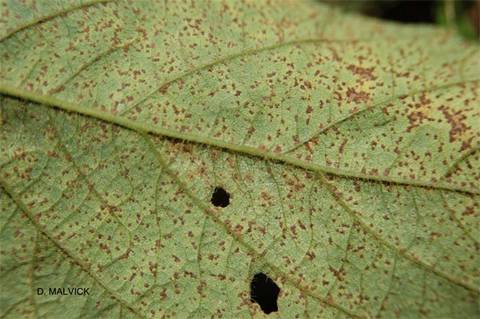Soybean
Rust

Phakopsora pachyrhizi
Fungal Disease

Phakopsora pachyrhizi
Fungal Disease

Phakopsora pachyrhizi
Fungal Disease

Phakopsora pachyrhizi
Fungal Disease
Soybean rust symptoms are most commonly observed on the leaves and will start in the lower canopy. Lesions can also develop on petioles, pods and stems. Symptom development occurs rapidly once the plant starts flowering and can result in significant levels of defoliation under favorable environmental conditions. Lesions first appear as small yellow and irregularly shaped spots. As the disease progresses, lesions enlarge to 1/16th to 1/12th of an inch in diameter, and are tan to dark reddish brown in color. Within each lesion are a few to several volcano-shaped uredinia (spore producing structures). As rust severity increases, plants prematurely lose their leaves and commonly mature early. Lesions from soybean rust can appear similar to other foliar diseases of soybean and can be confused with brown spot and bacterial pustule.
Soybean rust development is favored by temperatures ranging from 12°-21°C), with relative humidity above 90% for more than 12 hours. Soybean rust can be active with daytime temperatures as high as 37° C and possibly higher as long as night temperatures fall into the optimum range for disease development. In order for spores to germinate and infect the plant, six hours of continuous leaf wetness are required. Infection increases with longer leaf wetness periods up to 12 hours.




